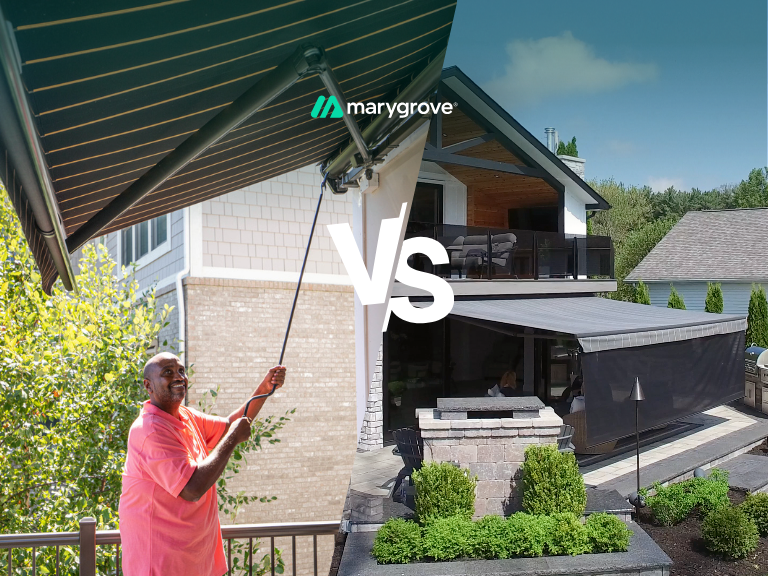Motorized retractable awnings offer better convenience, usability, and weather automation, while manual awnings suit smaller spaces and lower budgets. If you want daily comfort and frequent use, motorized is the clear winner for most modern outdoor setups.
Manual vs Motorized Awnings: Start With the Real-World Basics
Choosing between manual and motorized awnings comes down to usage and effort. Manual models rely on a crank and suit basic shade needs.
Motorized options offer app control, smart features, and easy operation, ideal for patios, poolside areas, or any space you use daily.
Here’s a quick comparison to start:
- Manual awnings are lower cost, DIY-friendly, and power-free
- Motorized awnings are convenient, automated, and often used more
- Manual systems require effort; motorized work with app or remote
- Smart features, voice control, and wind sensors are motorized-only
- Usage tends to be 2x higher with motorized setups
There’s more to the decision than just cost, and the details could save you future hassle or regret.
If you’re still weighing the trade-offs, keep reading.
The real-world differences in maintenance, weather response, and long-term value might just help you choose with confidence.
How Manual and Motorized Awnings Work
Before comparing features, it’s helpful to understand how each system operates. Both provide shade when you need it, but how you control them can shape your experience.
1. Manual Awnings: Simple and Hands-On
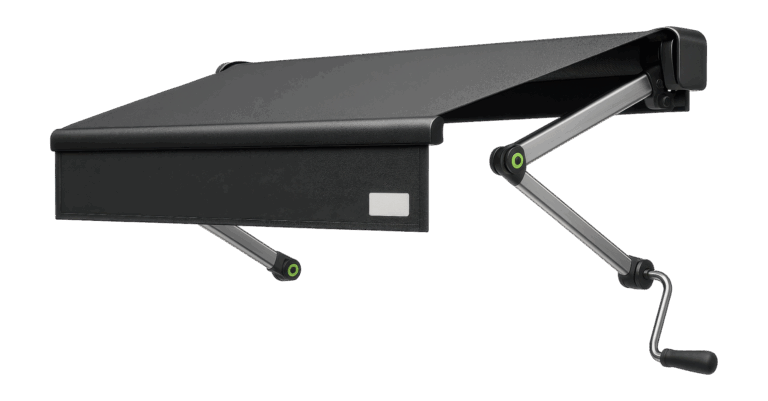
Manual retractable awnings use a crank handle or pulley to extend and retract the canopy. With no motor or wiring involved, they’re straightforward to install and maintain.
This makes them a solid choice for smaller spaces, budget-conscious projects, or areas where power access is limited.
That said, they do require physical effort every time you use them. Over time, this can be less convenient, especially for wider awnings or daily use.
2. Motorized Awnings: Seamless and Smart
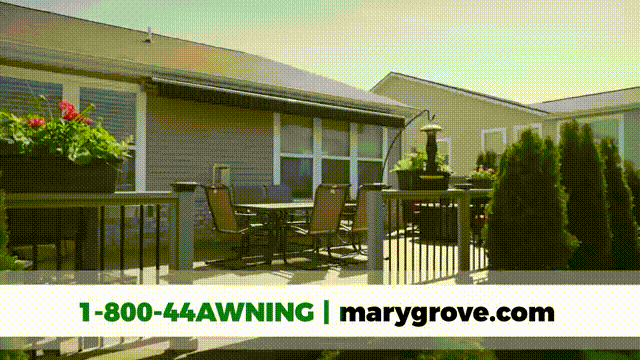
Motorized awnings use a built-in motor controlled by remote, wall switch, or app. Many models include voice control and weather sensors for hands-free operation.
With clean, concealed arms and automated features, they suit modern homes well and are often preferred for their long-term ease and comfort.
With the basics covered, let’s look at how these two systems compare when it comes to real-world use, like maintenance, cost, and convenience.
7 Key Differences Between Manual and Motorized Awnings
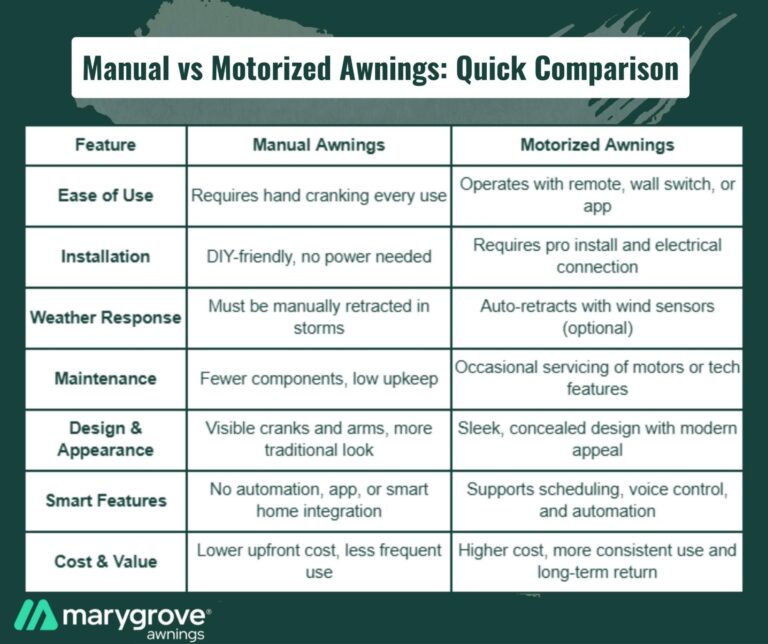
With the basics covered, it’s time to compare how these awning types perform in everyday use.
From cost and convenience to weather-readiness and smart features, these seven differences can help guide your decision.
Whether you’re shading a sunny patio or covering a poolside lounge, the right choice can also add long-term value to your home.
1. Ease of Use and Accessibility
How you open and close your awning plays a big role in how often you’ll actually use it. This is especially important for frequently accessed areas like decks, outdoor kitchens, or backyard dining zones.
Manual Retractable:
Operated by a hand crank or pulley, manual awnings require physical effort every time. This can become tiring, especially for wider spans or older users shading patios or garden-facing doors.
Motorized Retractable:
Controlled by remote, wall switch, or smartphone app. Effortless to use, making them ideal for poolside seating, balconies, or high-traffic outdoor spaces.
If convenience matters, motorized awnings are easier to use and encourage more frequent shade control.
2. Installation and Flexibility
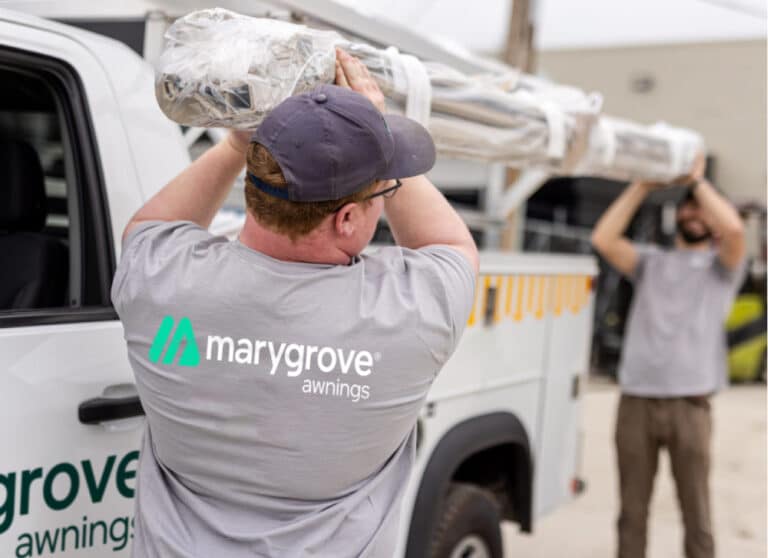
How your awning is installed depends on your layout and how permanent you want it to be.
Manual Retractable:
Typically easier to install. No wiring required, making them suitable for brick exteriors, detached garages, or garden patios.
Motorized Retractable:
Requires professional install and electrical access. Offers a cleaner, more integrated look for outdoor kitchens, lanais, or modern decks.
Manual works for simple setups, but motorized fits long-term upgrades better.
3. Smart Features and Integration
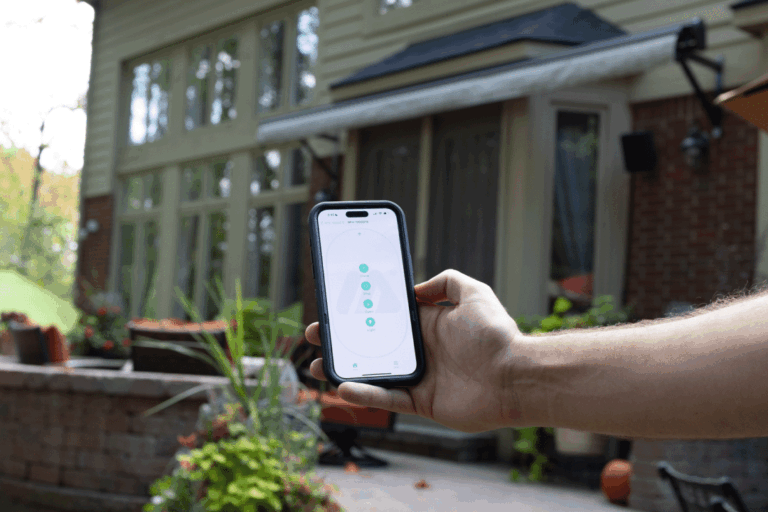
If your home includes outdoor tech, like lighting or irrigation, awnings can be part of that ecosystem.
Manual Retractable:
Strictly mechanical. No timers, apps, or smart features.
Motorized Retractable:
Many include app control, voice activation, and programmable sensors. Ideal for smart-enabled patios or connected lounging areas.
For automation and tech compatibility, motorized systems are the better fit.
4. Maintenance and Longevity
The upkeep your awning requires can affect how well it performs over time.
Manual Retractable:
With fewer moving parts, manual awnings tend to need less maintenance. Occasional checks and lubrication are usually enough for seasonal spaces like cabin decks or balconies.
Motorized Retractable:
Motorized models include motors and tech, but many are built with heavy-duty components designed for frequent use. When installed properly, they can deliver years of reliable performance with minimal service.
If you want a low-maintenance option for light use, manual works. But for daily shade in active outdoor spaces, motorized awnings offer both durability and long-term ease.
5. Design and Aesthetic Appeal
Your awning should look good as well as work well, especially in areas visible from your home’s main living spaces.
Manual Retractable:
Often has visible cranks and support arms. Functional, but may not complement updated exteriors.
Motorized Retractable:
Features concealed arms and streamlined housing for a cleaner finish on verandas or outdoor entertaining zones.
For modern aesthetics, motorized awnings offer a sleeker solution.
6. Weather Response
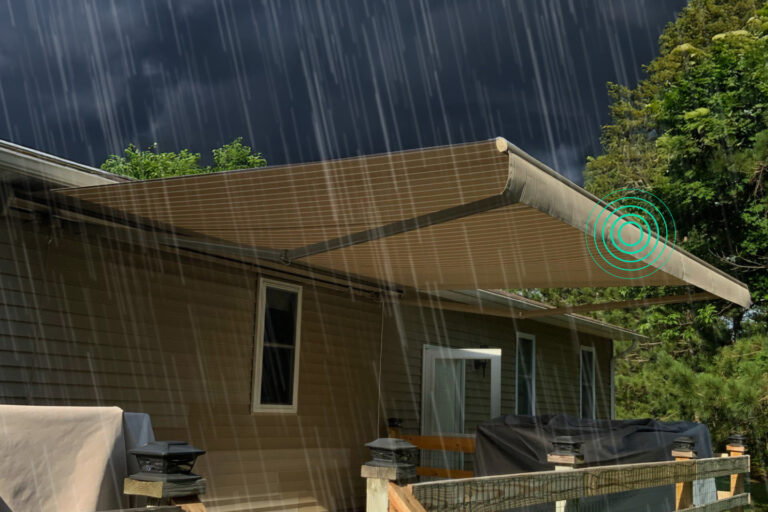
Weather shifts quickly, especially during the summer. How your awning responds can protect furniture, grills, and outdoor seating areas.
Manual Retractable:
You’ll need to retract it manually when storms or high winds roll in.
Motorized Retractable:
Often includes wind sensors that retract automatically when gusts are detected, protecting patios or poolside furniture even when you’re not home.
If you want built-in protection, motorized systems reduce weather-related stress.
7. Cost and Overall Value
Cost is always a factor, but so is how much you’ll actually use your awning once it’s installed.
Manual Retractable:
Lower upfront cost. A good option for smaller decks or seasonal setups, but usage tends to drop due to the manual effort.
Motorized Retractable:
Costs more initially but encourages daily use. Adds comfort, resale value, and consistent shade for pool decks, patios, or high-use zones.
If you’re thinking long term, motorized often delivers more return on investment.
Pro Tip: Motorized awnings are used more than twice as often as manual ones, especially in high-use areas like patios, poolside lounges, and outdoor kitchens.
That consistent use translates to better long-term value and more enjoyment from your space.
Now that you’ve seen how each awning type compares, let’s look at the pros and cons of both, and when one clearly makes more sense than the other.
Helpful Resource → How Much Do Retractable Awnings Cost in 2025? [Full Pricing Guide]
Pros, Cons, and the Clear Use Case for Each Awning Type
Choosing between manual and motorized retractable awnings isn’t just about budget, it’s about how you use your outdoor space and what matters most day to day.
Below, we’ll break down the strengths and trade-offs of each option so you can make the call that fits your home best.
Manual Retractable Awnings: The Rugged, Budget-Friendly Option
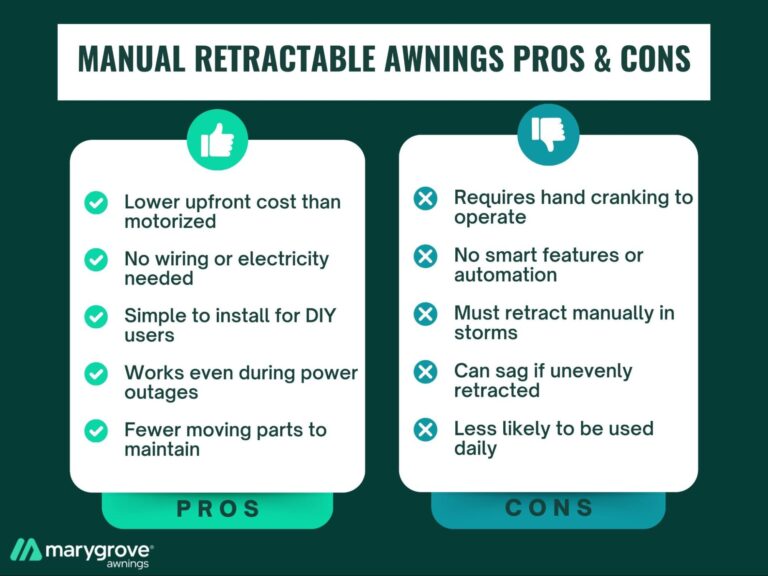
Manual awnings offer a straightforward way to create shade without relying on electricity or advanced technology.
While they meet the needs of many homeowners, especially for basic or seasonal use, they’re generally best suited for simpler setups.
Pros:
Manual awnings have a few practical advantages, mostly around cost and simplicity. These benefits are helpful in certain situations but come with trade-offs in daily convenience.
- Lower upfront cost compared to motorized models
- No need for power supply or wiring access
- Simple to install for experienced DIY homeowners
- Continues to function during power outages
- Can offer good wind stability with support poles
These pros make manual awnings a workable option, but they often come at the cost of everyday ease and comfort.
Cons:
Manual awnings are limited in features and require regular physical effort to operate.
- Requires manual cranking every time it’s used
- Less likely to be opened or adjusted regularly
- No built-in weather response or safety sensors
- Fabric may sag if retracted unevenly
- Cannot be integrated with smart home systems
Where Manual Awnings Make Sense:
Manual retractable awnings work well in smaller, low-traffic areas where power access is limited or convenience isn’t the main concern.
They’re ideal for off-grid cabins, seasonal setups, or hands-on homeowners who prefer simplicity and don’t plan to adjust the awning frequently.
Motorized Retractable Awnings: The Smarter, More Comfortable Option
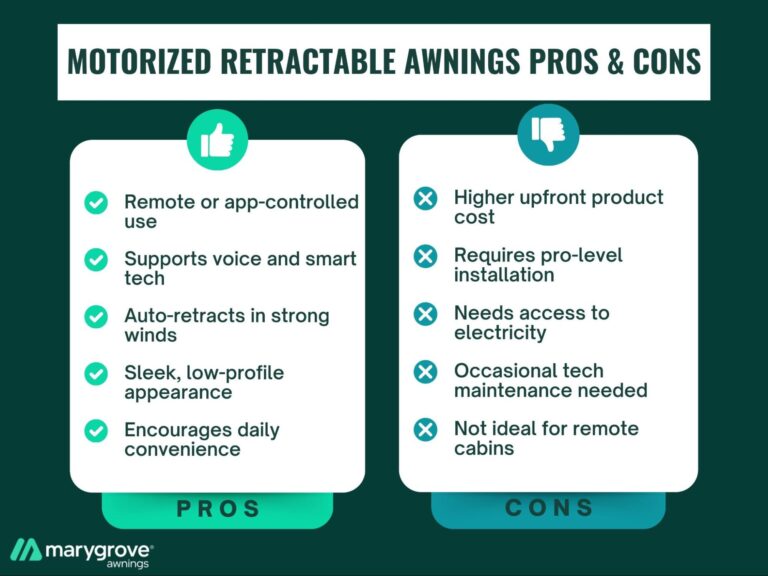
Motorized awnings are designed for convenience, consistency, and ease of use.
They’re often chosen for high-use areas like patios, outdoor dining spaces, or poolside setups where effortless shade control is a priority.
Pros:
These awnings are built for long-term comfort and frequent use. Their advantages often come into play when you want to make the most of your outdoor space without extra effort.
- Operates with remote, wall switch, or smartphone app
- Compatible with voice control and automation features
- Includes sensors that respond to wind or sun exposure
- Sleek design with concealed arms and cleaner lines
- Encourages more regular use due to easy operation
For homeowners who value daily comfort, smart features, or long-term convenience, motorized awnings offer a more complete experience.
Cons:
While motorized systems provide more features, they do come with higher costs and some added complexity.
- Higher initial investment compared to manual models
- Requires power, though some models work manually during outages.
- May need occasional motor or remote maintenance
- Occasional tech maintenance needed
- Less ideal for off-grid setups or remote locations
Where Motorized Awnings Make Sense:
Motorized retractable awnings are ideal for high-use patios, decks, or poolside areas where daily comfort, weather protection, and design matter.
Their smart features and ease of operation make them a practical choice for modern homes, especially when long-term convenience and property value are part of the decision.
Final Take: Which Awning Delivers What You Really Need?
Manual and motorized awnings both get the job done, but how they do it makes all the difference.
If you’re looking for something simple, affordable, and hands-on for a secondary space or seasonal setup, manual awnings can hold their own.
But if you want consistent comfort, easy operation, and better protection for your outdoor living areas, motorized awnings tend to offer more value over time.
What To Expect At Your Marygrove Awning Installation
The real deciding factor is how often you’ll use it, and whether you want your awning to work around your life, or the other way around.
Looking for a retractable awning that combines comfort, style, and real smart-home convenience?
Explore Marygrove’s line of motorized awnings to see how easy it is to upgrade your outdoor space, professionally installed and built to last.
